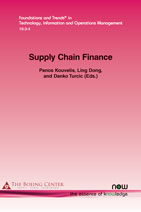Supply Chain Debt Financing in Competition
By Qiaohai (Joice) Hu, University of Missouri-St. Louis, USA, Joice.Hu@Gmail.com | Ping Su, Hofstra University, USA, Ping.Su@Hofstra.edu
Abstract
The seminal paper of Brander and Lewis (1986) concludes that debt financing causes two firms that engage in a Cournot game to behave more aggressively in the product market. However, both firms are worse off than if they are purely equity financed, resulting in the so-called prisoner’s dilemma. Incorporating two supply chain structures, distributional and parallel, we explore the effect of supply chain upstream structure on the downstream retailers’ strategic use of debt. We find that this prisoner dilemma persists because the upstream benefits from the intensified downstream competition. Moreover, the supply expansion effect is more pronounced in the parallel structure than in the distributional one, because each dedicated supplier in the parallel structure abets its retailer to compete more aggressively against the competitor by lowering its wholesale price. Therefore, the strategic effect of debt financing not only deters the competitor but also “squeezes” its supplier. In contrast, the common supplier in the distributional structure adopts an inertia strategy, keeping the same price regardless of the downstream’s debt levels because overheated downstream competition may be detrimental to it.
Supply Chain Finance
Supply Chain Finance focuses is on creating liquidity in the supply chain through various Buyer or Seller-led solutions with or without a facilitating technology. The role of supply chain finance (SCF) is to optimize both the availability and cost of capital within a given buyer-supplier supply chain. To add further value, information on the physical flow of goods can be monitored. The coupling of information enables lenders to mitigate financial risk within the supply chain. The mitigation of risk allows more capital to be raised, capital to be accessed sooner, or capital to be raised at lower rates. Supply chain participants reside in diverse economic environments, are of different sizes, face a variety of uncertainties, have different bargaining powers over its trading partners, and have different accessibilities to capital markets. Many forms of financing arrangements between buyers and suppliers have emerged intending to overcome challenges in their specific economic and business environments.
Part 1 examines Supplier Financing. The three papers included in this section discuss supplier based financing issues including: motivation and rationale for supplier based financing, the optimal mix of bank financing and supplier financing, and empirical study of the impact of trade credit on firm performance. Part 2 focuses on Buyer Financing including three papers included that discuss buyer based financing issues in supply chains including the rationales of different types of buyer based financing arrangements and their impacts on supply chain performance. Part 3 reviews Inventory Models and Financing Consideration and the two papers in this part of the book explore how to coordinate the management of the cash flow and inventory flow within an organization and the relationship between a firm’s inventory policy and its cost of capital. Part 4 examines Operational Investments and Financing Issues and includes four papers that address operational investments with explicit financing considerations.

Companion
Foundations and Trends® in Technology, Information and Operations Management, Volume 10, Issue 3-4 Special Issue: Supply Chain Finance
See the other articles that are also part of this special issue.